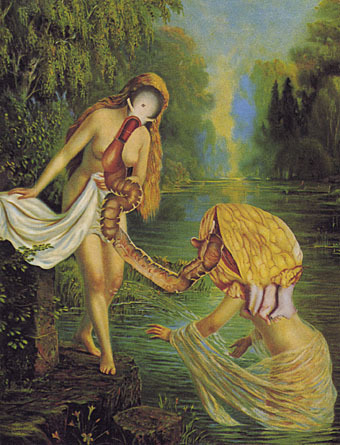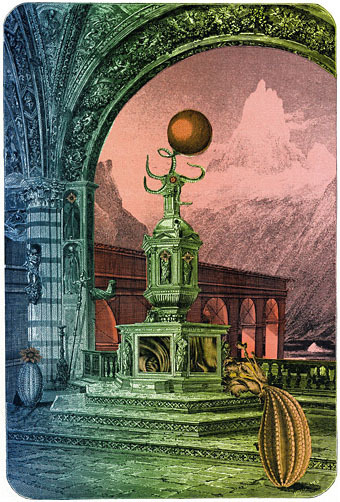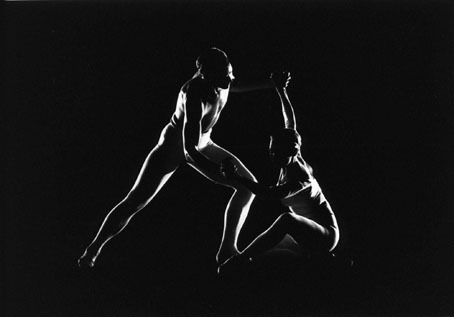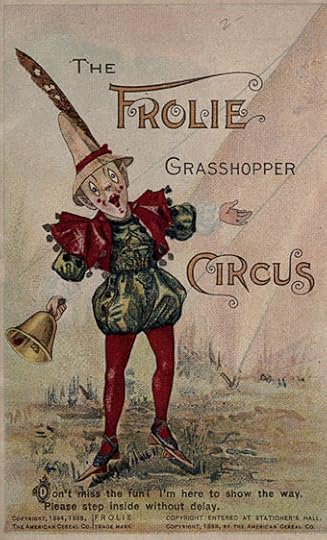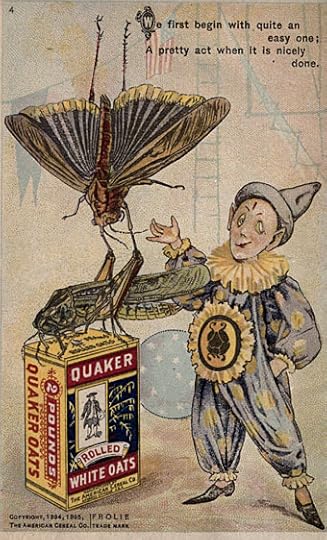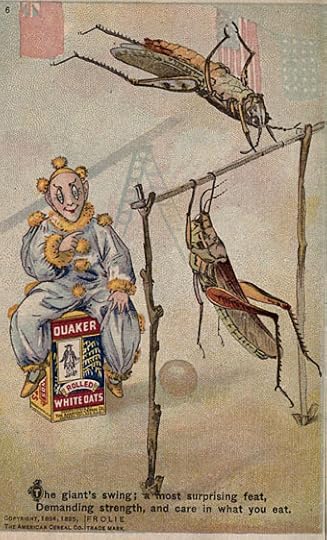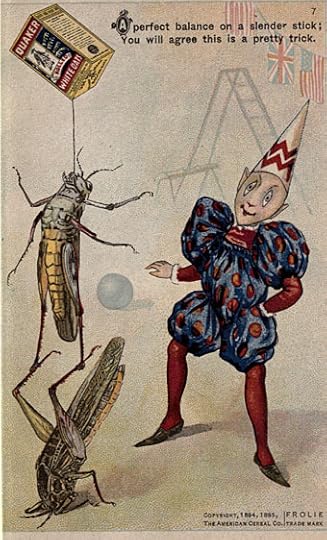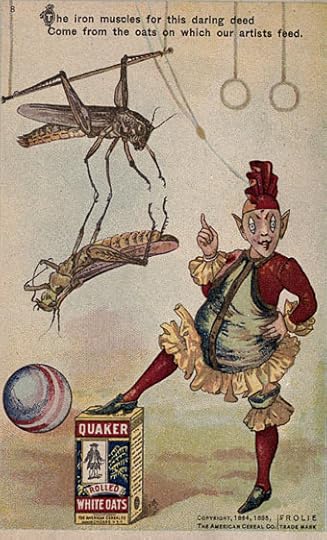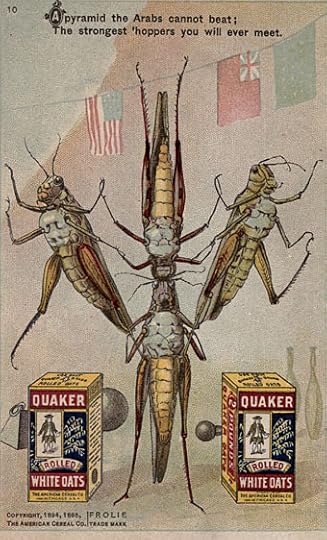John Coulthart's Blog, page 293
November 2, 2011
The art of Jindrich Styrsky, 1899–1942
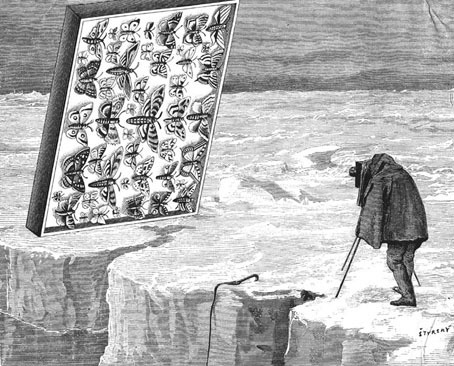
From a late Surrealist to an early one. Jindrich Styrsky is a Czech artist best remembered today for his collages but he was also a painter, a photographer and a publisher of erotic material. He illustrated and published a Czech edition of Lautréamont's Maldoror, and helped found the Surrealismus review in Prague.
The Bathe (1934).
Regular readers won't be surprised to hear that I've liked Styrsky's collages for years, many of which subject sentimental Victorian illustration to processes of violent transmutation. Ever since seeing The Bathe I've found it impossible to look at one of Renoir's fleshy nudes without wondering what happened to the exposed viscera. Weimar covered Styrsky's career in some detail last year so that's a good place to go for further information. There's an extract from Styrsky's dream diary here, and a substantial collection of the collage work and other material at this Flickr set.
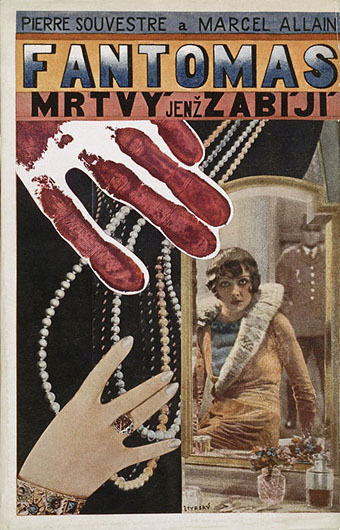
Cover for a Czech edition of Fantômas (1929).
Elsewhere on { feuilleton }
• The fantastic art archive
Previously on { feuilleton }
• Initiations in the Abyss: A Surrealist Apocalypse
• Vultures Await
• Wilfried Sätty: Artist of the occult
• Illustrating Poe #4: Wilfried Sätty
• Metamorphosis Victorianus
• Max (The Birdman) Ernst
• Gandharva by Beaver & Krause
• The art of Stephen Aldrich
November 1, 2011
Klaphek versus Ballard
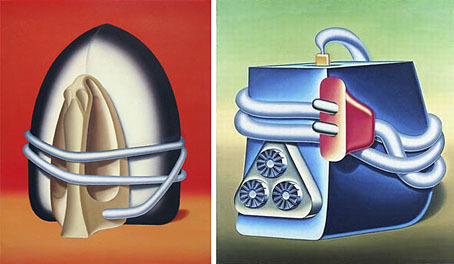
left: The Hostage (1966); right: The Female Terrorist (1971). Both by Konrad Klaphek.
No, I'm not suggesting that David Pelham's paintings for the Ballard covers he designed in the 1970s are inspired by the earlier work of German artist Konrad Klaphek. But it's tempting to think of Klaphek's isolated objects as being intended for Ballard collections that never saw the light of day. Klaphek has connections with late Surrealism, and some of his paintings pre-figure the styles and concerns of some Pop Art, so I'm sure Ballard would have approved.
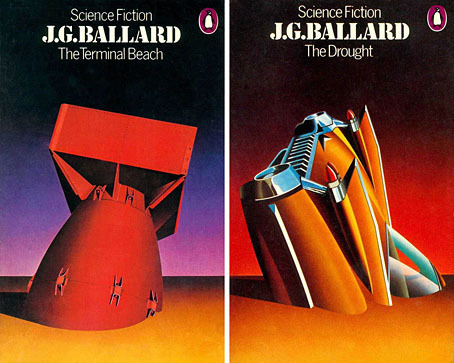
Three of Pelham's memorable Ballard paintings were made available as signed and numbered prints earlier this year, together with his design for A Clockwork Orange. For more about the covers see Landscapes From a Dream: How the Art of David Pelham Captured the Essence of JG Ballard's Early Fiction, an essay at Ballardian. The designer discussed his career at some length in 2007. Then there's the complete set of covers at the Penguin Science Fiction site, and let's not forget Konrad Klaphek who's still painting and who has a website here.
Elsewhere on { feuilleton }
• The book covers archive
October 31, 2011
Alice in Liverpool
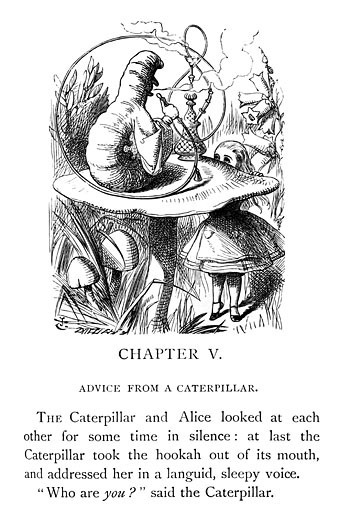
Alice and the Caterpillar (1865) by John Tenniel.
It's perhaps surprising that an art gallery, rather than a library, is holding a huge survey exhibition about Alice, but then Carroll's creation has been and still is the inspiration of artists, photographers, theatrical designers, animators, film-makers.
Thus Marina Warner writing about an exhibition of art based on Lewis Carroll's Alice books opening at Tate Liverpool this Friday:
Alice in Wonderland will offer visitors a rare opportunity to view Carroll's own drawings and photographs, alongside Victorian Alice memorabilia and John Tenniel's preliminary drawings for the first edition of the novel.
Carroll's stories were soon adopted by other artists. Surrealist artists from the 1930s onwards were drawn towards the fantastical world of Wonderland where natural laws were suspended. From the 1960s through the 1970s, Carroll's Alice tales also prompted conceptual artists to explore language and its relationship to perception, and the stories inspired further responses in Pop and Psychedelic art. Expect to see works by artists ranging from Salvador Dalí and René Magritte, to Peter Blake and Yayoi Kusama. (more)
The exhibition runs to January 29th, 2012, and I suppose this gives me a convenient opportunity to point again to my psychedelic Alice calendars which have been updated for the forthcoming year.
Previously on { feuilleton }
• Coulthart calendars for 2012
• Scenes from a carriage
• Through the Psychedelic Looking-Glass: the 2011 calendar
• Jabberwocky
• Alice in Acidland
• Return to Wonderland
• Dalí in Wonderland
• Virtual Alice
• Psychedelic Wonderland: the 2010 calendar
• Charles Robinson's Alice's Adventures in Wonderland
• Humpty Dumpty variations
• Alice in Wonderland by Jonathan Miller
• The Illustrators of Alice
October 30, 2011
A playlist for Halloween: Orchestral and electro-acoustic
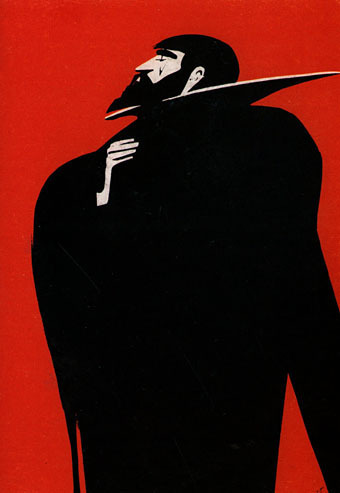
Bluebeard (1982) by János Kass.
I thought I might not be able to do a fresh playlist this year, so much has already been covered by the previous lists (see the links below to earlier posts). The search for new tonalities and timbres in 20th-century orchestral music led many composers to produce works that sound like—and have been used as—horror film soundtracks although you'll never find critical discussion acknowledging such a vulgar reaction. This is a very masculine list although some of the performers are women. I might have included Diamanda Galás but she was in the first list, as was Delia Derbyshire with her associates in White Noise, the subject of a longer post here.
The Isle of the Dead (1909) by Sergei Rachmaninov
Mentioned here a few days ago, Rachmaninov's suitably sombre piece is one of many compositions to borrow the medieval Dies Irae hymn for one of its themes.
Bluebeard's Castle (1911) by Béla Bartók
Frank Zappa once said that his initial response upon hearing the music of Edgard Varèse was "These chords are mean; I like these chords." I feel the same about Bartók's music which can get very mean indeed. The obvious piece to mention would be the Adagio from Music for Strings, Percussion and Celeste which Stanley Kubrick used in The Shining. Instead I've selected Bartók's only opera, a psychodrama for two performers and orchestra in which Bluebeard's new wife, Judith, explores the castle (which also represents her husband's character) only to find everything there stained with blood.
Visage (1961) by Luciano Berio
In which Berio records his wife and frequent collaborator, Cathy Berberian, then dissects her vocalisations to disturbing effect. "Visage contains no singing, and virtually no words," says Martin Butler. "The product of days of gruelling recording for Berberian (leaving her physically damaged), it instead consists of her laughter, moans and groans, snorts and wheezes, and gibberish, all brilliantly edited, filtered, distorted and mixed with electronic backing. It is a remarkable demonstration of the power of the wordless voice. The effect is shocking and extreme, but also hilarious and touching – and often all these things simultaneously."
Bohor (1962) by Iannis Xenakis
In addition to making some of the most thrilling and advanced new music of the 20th century, Xenakis chose great titles for his compositions, frequently unusual words. Bohor is a recording of layered sound sources that include a Laotian mouth organ, prepared piano, Iraqi and Hindu jewellery, and should ideally be heard with the sounds surrounding the listener. Intended by its composer to represent "the onset of madness".
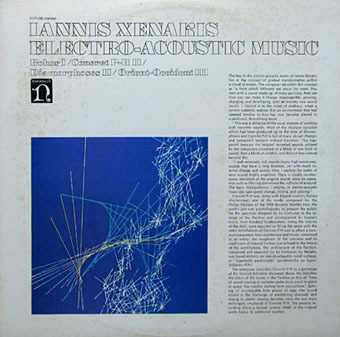
Design by Paula Bisacca.
Uaxuctum: The Legend of the Maya City, Destroyed by Themselves for Religious Reasons (1966) by Giacinto Scelsi
And speaking of great titles… The Italian composer uses orchestra, a choir and an Ondes Martenot to convey an ancient apocalypse. Part III was selected by Robbie Robertson (along with works by other composers listed here) for the Shutter Island soundtrack.
Lontano (1967) by György Ligeti
Stanley Kubrick used Ligeti's music in three of his films. Lontano's piercing harmonics and growling chords prowl through The Shining together with pieces by Bartók and Penderecki.
Black Angels: Thirteen Images from the Dark Land (1970) by George Crumb
Many of the pieces here jangle the nerves but none more than Crumb's composition for string quartet, glass and metal instruments, a part of which is used in The Exorcist. Composed "in time of war", it's a howl of despair whose opening manages to be even more disturbing than Penderecki's Threnody for the Victims of Hiroshima. The 1990 Kronos Quartet recording is essential.
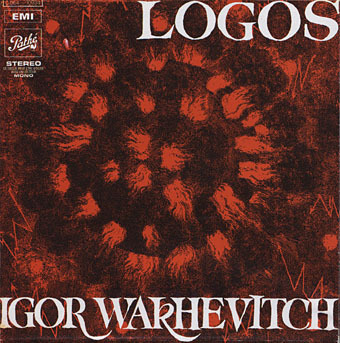
Logos (Rituel Sonore) (1970) by Igor Wakhévitch
"Sound ritual for pop group, mixed choir and magnetic tape." The first album by the elusive French composer, a composition for a ballet, described by Alan Freeman as "a soprano singer, strange orchestral textures and percussives (drums, cymbals, gongs, etc.) blended with effects and processing. As the ominous percussion sets off with drum-rolls and ritualistic tension, the mood is of a looming anticipation of what is to come. Here we go through phases of weird swirling effects, vivid reverb and atmosphere. The tension becomes overpowering, yet we are led on…"
The Dream of Jacob (1974) by Krzysztof Penderecki
The Polish composer wrote for film soundtracks as well as the concert hall so it's no surprise that his work can be heard in The Exorcist, The Shining and Shutter Island. The atmosphere of sustained malevolence in this piece is perfect for Kubrick's haunted house. Whatever Jacob was dreaming about, it wasn't pleasant.
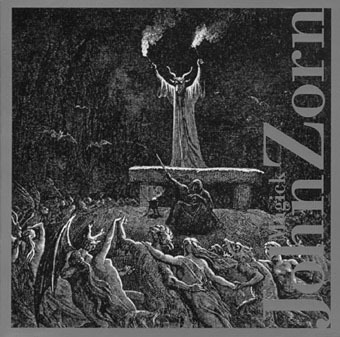
Design by Heung-Heung Chin.
Necronomicon (2004) by John Zorn
A five-part composition for string quartet from Zorn's Magick album.
Previously on { feuilleton }
• Powell's Bluebeard
• A playlist for Halloween: Drones and atmospheres
• A playlist for Halloween: Voodoo!
• Dead on the Dancefloor
• Another playlist for Halloween
• A playlist for Halloween
• The music of Igor Wakhévitch
October 29, 2011
Weekend links
At the Mountains of Madness (1979) from Halloween in Arkham by Harry O. Morris.
• Golden Age Comic Book Stories always pulls out the stops in the run up to Halloween. In addition to a wonderful collection of Harry O. Morris collages, Mr Door Tree has also been posting Virgil Finlay's illustrations for Edgar Allan Poe, Lynd Ward's tremendous illustrations for a collection of weird tales entitled The Haunted Omnibus, Barry Moser's woodcuts for an edition of Frankenstein, and Virgil Finlay's illustrations for stories and poems by HP Lovecraft.
• "Eugene Thacker suggests that we look to the genre of horror as offering a way of thinking about the unthinkable world. To confront this idea is to confront the limit of our ability to understand the world in which we live – a central motif of the horror genre. In the Dust of This Planet explores these relationships between philosophy and horror."
• "…the reader [...] becomes a conscious participant in the process of imposing a linear sequence, while at the same time remaining aware that all narrative is an act of memory, and that memory is necessarily random." Jonathan Coe reviews Marc Saporta's book-in-a-box, Composition No.1, recently republished by Visual Editions.
• Nearly fifty years after its first performance, Peter Weiss's Marat/Sade is still disturbing playgoers. And nearly ninety years after its release, Alla Nazimova's silent film production of Oscar Wilde's Salomé is touring the UK with live musical accompaniment.
• Tom of Sinland at Homotography, in which illustrator Bendix Bauer portrays some of the fashion world's notable male designers as Tom of Finland-style characters for Horst magazine.
• Neil Gaiman Presents is a new audiobook imprint which launches with works by Jonathan Carroll, Alina Simone, Keith Roberts, M. John Harrison and Steven Sherrill.
• The Weird Wild West: Paul Kirchner has put all his Dope Rider comic strips online.
• Leonora Carrington prints at Viktor Wynd Fine Art, London, from November 5th.
• The Fall to Earth: David Bowie, Cocaine and the Occult.
• Photos of New York City, 1978–1985.
• Kathy Acker recordings at Ubuweb.
• The Occupied Times of London.
• The Golden Age of Dirty Talk.
• This week I've been lost in the Velvet Goldmine (again): John, I'm Only Dancing (1972) by David Bowie | The Jean Genie (1972) by David Bowie | Drive-In Saturday (1973) by David Bowie.
October 28, 2011
A Picture to Dream Over: The Isle of the Dead
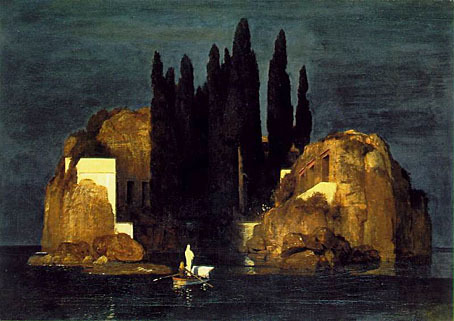
The Isle of the Dead (second version, 1880), Kunstmuseum, Basel.
In the sudden flares of light over the water, reflected off the sharp points of his cheeks and jaw, a harder profile for a moment showed itself. Conscious of Sanders's critical eye, Father Balthus added as an afterthought, to reassure the doctor: "The light at Port Matarre is always like this, very heavy and penumbral – do you know Böcklin's painting, 'Island of the Dead', where the cypresses stand guard above a cliff pierced by a hypogeum, while a storm hovers over the sea? It's in the Kunstmuseum in my native Basel –"
The Crystal World (1966) by JG Ballard.
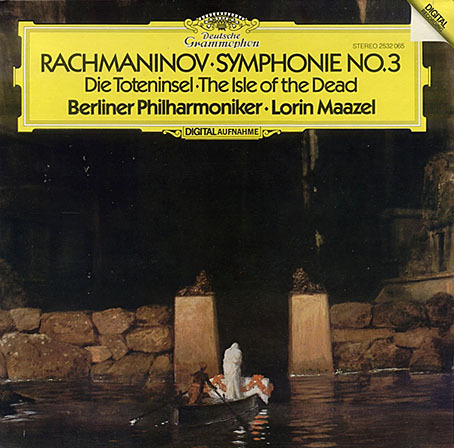
A 1982 recording.
Today's post is another guest piece over at Tor.com where I run through a history of some of the works in different media inspired by Arnold Böcklin's The Isle of the Dead (1880–1886). The four versions of Böcklin's painting are favourites of mine so I've touched on this subject a couple of times before but this is the first time I've gone into any detail examining their influence. Many artworks have become highly visible in the past century via copies, parodies and imitations: think of Leonardo's Mona Lisa and The Last Supper, or Michelangelo's David and The Creation of Adam. What's fascinating about The Isle of the Dead is that it's not one picture but four versions of the same scene, and they've all been very influential not as parodies but as direct inspirations for other artworks—musical compositions, feature films, a novel—yet few people would recognise the artist's name. My post only scratches the surface by running through some of the more well-known works but there's a whole website devoted to the subject for anyone wishing to investigate further.
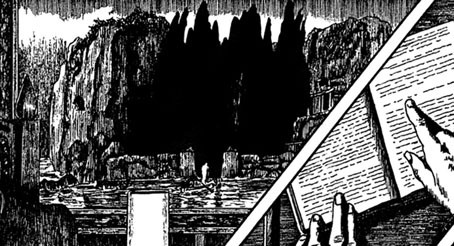
The Call of Cthulhu (1988).
Modesty prevented me from mentioning my own work in the Tor post but I'll do so here. Among the many references ladled into my adaptation of The Call of Cthulhu there's the 1886 Leipzig version of Böcklin's painting in the background of a panel. A prefiguring of the end of the story and also an excuse to add to the list of works acknowledging one of the great Symbolist paintings.
Previously on { feuilleton }
• The Isle of the Dead in detail
• Arnold Böcklin and The Isle of the Dead
October 27, 2011
Ver Sacrum, 1899
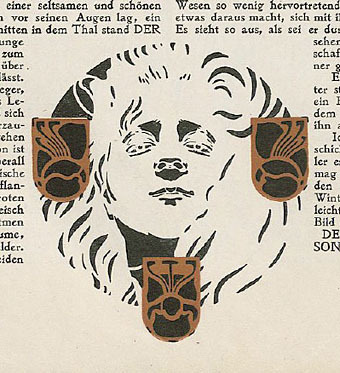
Another post about Ver Sacrum, the art journal of the Viennese Secession and one of the world's major art magazines during its short run from 1898 on. This is another digitised edition from the University of Heidelberg's archive and is the second volume of the journal's monthly issues. It's difficult to make a small selection from over 450 pages of high-quality Art Nouveau graphics and design so I've mostly chosen the covers again. Anyone wanting to see more is encouraged to download the whole volume or browse individual pages here.
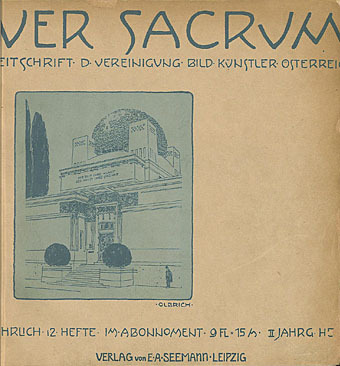
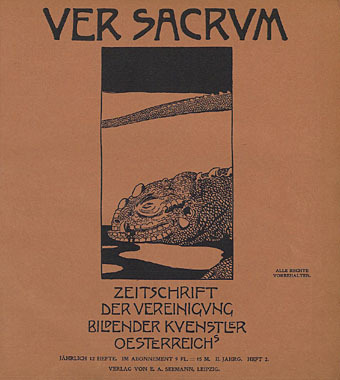
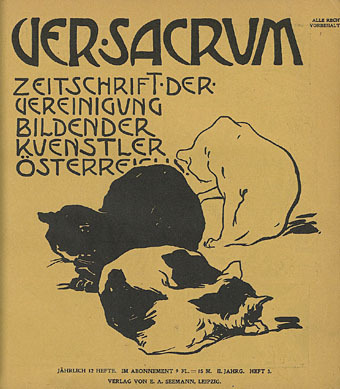
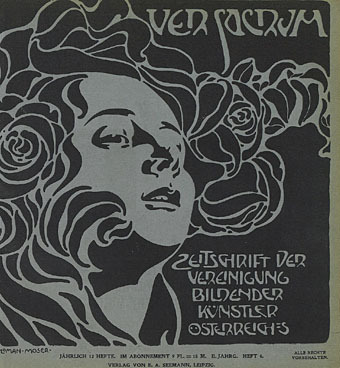
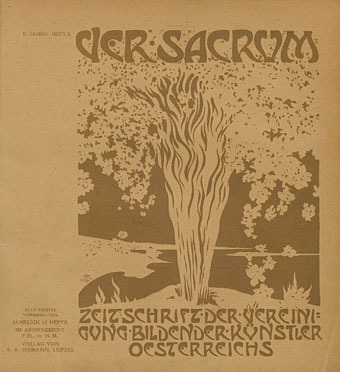
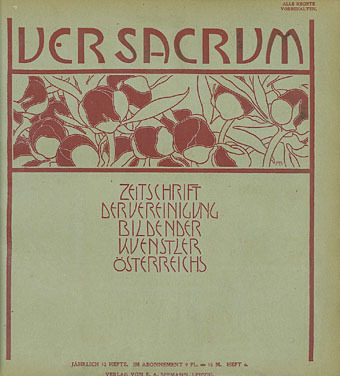
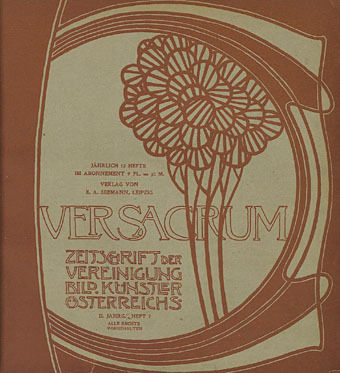
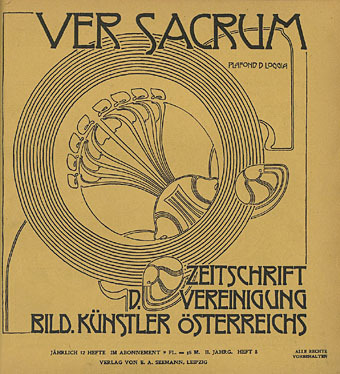
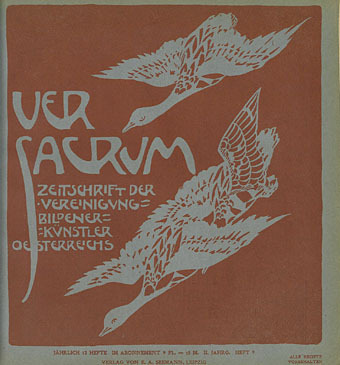
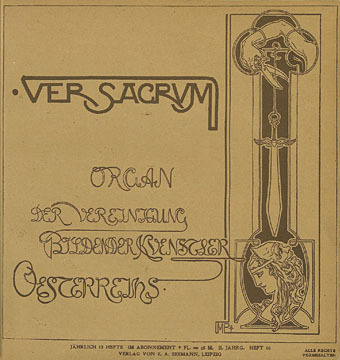
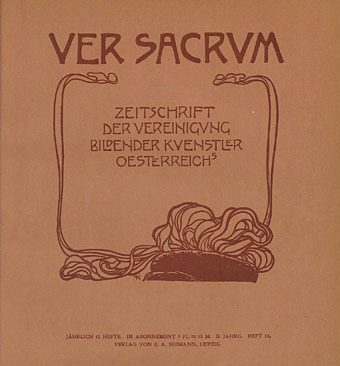
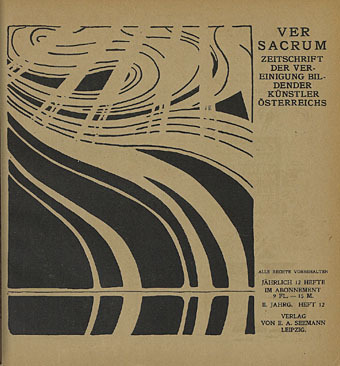
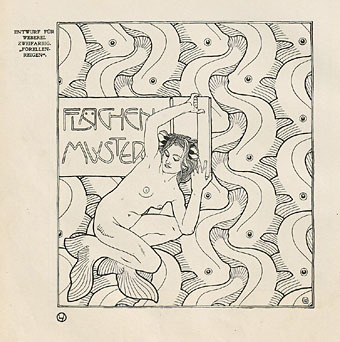
One of many tesselated patterns from the remarkable Koloman Moser. I've wondered a few times whether his repeated animal shapes were an influence on MC Escher's similar designs.
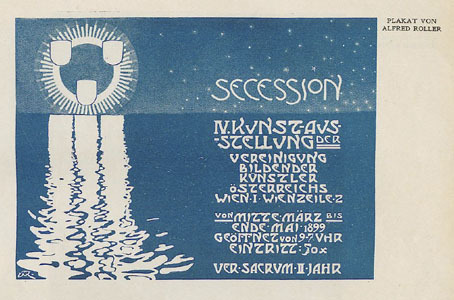
Previously on { feuilleton }
• Ver Sacrum, 1898
• Secession posters
October 26, 2011
Pas de Deux by Norman McLaren
Norman McLaren's 1968 film is not only one of the greatest ballet films ever made, it's also an astonishing combination of high-contrast photography and optical printing. Choreography by Ludmilla Chiriaeff, dance by Margaret Mercier and Vincent Warren, music by Dobre Constantin and the Folk Orchestra of Romania. YouTube isn't the ideal medium to watch anything like this but there's now a quality copy here in all its 13-minute glory. If you've never seen it, do so before it vanishes.
Previously on { feuilleton }
• Norman McLaren
October 25, 2011
The Classical alibi in physique photography
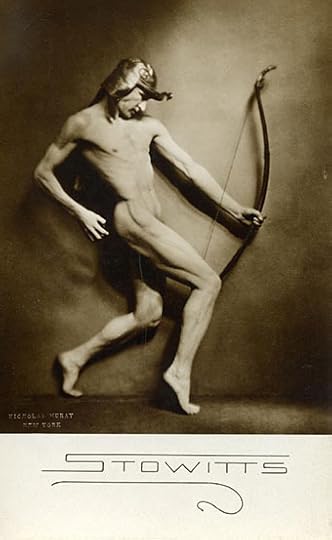
Stowitts photographed by Nickolas Muray.
The title is from two gallery pages at the Queer Arts Resource which runs through a history of the old subterfuge whereby homoerotic pictures were decorated to look suitably Greek or Roman. This seldom fooled anyone, even in Oscar Wilde's day, but it no doubt helped to keep the studios out of the law courts. Amid the plaster columns and antique props there's a card I hadn't seen before promoting dancer and artist Hubert Stowitts whose role as a satyr is one of the most memorable moments in Rex Ingram's 1926 film of The Magician.
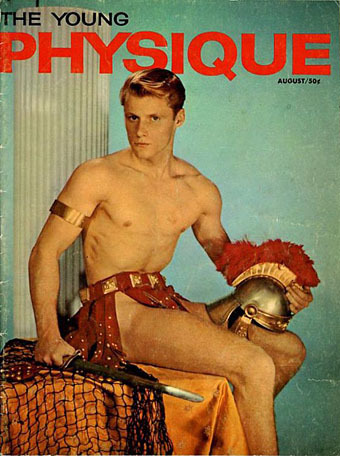
Jim Galahad.
Also at Queer Arts is a copy of The Dying Gaul with a model who's in the peak of health and a lot more well-hung than most Greek sculptures.
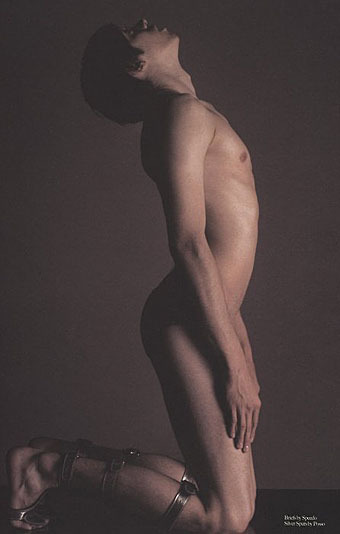
This picture is something I found ages ago on a lost web page and now have a tenuous reason to post here. What looks like erotica is actually a fashion shoot (and he's wearing swimming trunks) but it shows how the Classical mode persists. He looks like he wants to see more of Jim's sword…
Elsewhere on { feuilleton }
• The gay artists archive
• The men with swords archive
October 24, 2011
The Frolie Grasshopper Circus
For a taste of the unalloyed strangeness of the past you have to bypass the fine art and cultivated histories and look to the ephemera. The Frolie Grasshopper Circus (1898) is an uncredited booklet for American children made to promote Quaker Oats, and it does so in a manner far removed from today's bland and focus-grouped campaigns. The combination of grasshoppers and oats brings to mind crop-devastating swarms of locusts. And who are these slit-eyed insect-wrangling imps? The one on the cover is wearing a pair of stilt shoes like Horrabin the evil clown in Tim Powers' The Anubis Gates while one of his confederates bears the emblem of some sinister insect cult. There's more to this grotesque parade than meets the eye. The Internet Archive has all 16 pages if you need to know more.
Previously on { feuilleton }
• Detmold's insects
John Coulthart's Blog
- John Coulthart's profile
- 31 followers


